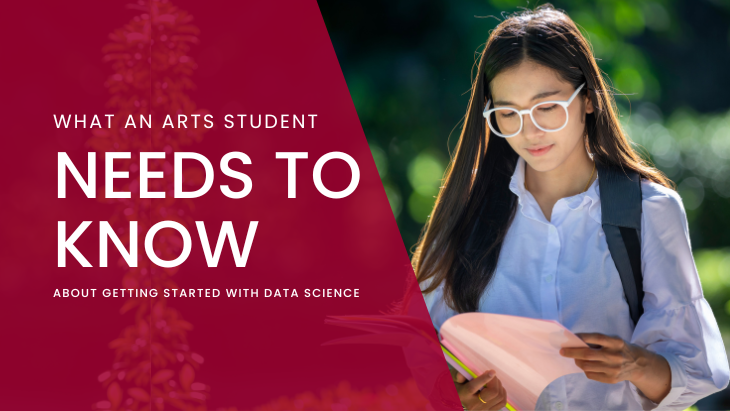Introduction
Data science is increasingly becoming a vital skill for the workplace, but many don’t know where to begin. If you’re an arts student looking to add data science to your resume, then there’s even more confusion – arts students tend not to think of “data” as part of their curriculum.
But the truth is that data science isn’t rocket science! It’s actually quite accessible and recognisable to those with an arts background.
In this article, I’m going to demystify data science for the arts student and share what they need to know about getting started in this field. We’ll look at the tools, skills, and resources required before you launch your career in data science.
What Is Data Science?
Data science is a field of study that combines mathematics, computer science, and statistics to extract insights from large datasets. It involves the use of algorithms and machine learning techniques to identify patterns in data and make predictions about future events. Data scientists are responsible for collecting, cleaning, analyzing, and interpreting data to gain meaningful insights.
For arts students, data science can be seen as an extension of their existing knowledge base. Arts students are already familiar with the concept of analysis – they’re used to looking at texts or images and making interpretations based on what they see. Data science simply takes this same approach but applies it to numerical data instead. By understanding how data works and how it can be manipulated, arts students can become proficient in using data-driven methods to solve problems in their chosen field.
A Solid Understanding of Computer Basics
Before you can get started with data science, it’s important to have a solid understanding of computer basics. This includes knowing how to use a computer operating system, such as Windows or Mac OS, and being familiar with basic software applications like Microsoft Office. You should also be comfortable navigating the internet and using web browsers like Chrome or Firefox. Additionally, having some experience with coding languages such as HTML, CSS, JavaScript, or Python will be beneficial for your data science journey.
Arts students may feel intimidated by the idea of learning computer basics but it doesn’t have to be difficult. There are plenty of online tutorials and resources available that can help you get up to speed quickly. For example, Codecademy offers free courses on coding languages like HTML and JavaScript that are perfect for beginners. Additionally, there are many free online resources available that provide step-by-step instructions on how to use different software applications and navigate the internet. With a bit of practice and dedication, arts students can become proficient in these essential computer skills in no time!
Find the Right Resources for Learning About Data Science
Once you have a basic understanding of computer basics, it’s time to start learning about data science. There are many resources available that can help you get started in this field. For example, online courses such as Coursera and Udacity offer comprehensive programs on data science topics such as machine learning and big data. Additionally, there are plenty of free tutorials and resources available online that provide step-by-step instructions on how to use different software applications for data analysis.
For arts students who want to learn more about the theoretical aspects of data science, books like “Data Science for Dummies” or “Data Science from Scratch” are great starting points. These books provide an overview of the fundamentals of data science and explain key concepts in an easy-to-understand way. Additionally, there are many blogs and websites dedicated to data science that provide helpful tips and advice on how to get started in this field.
Finally, attending conferences or workshops related to data science is a great way to network with other professionals in the field and gain valuable insights into the industry. Many universities also offer courses on data science topics which can be beneficial for those looking for a more structured approach to
Learn the Foundations of Data Science
Data science is an accessible field for arts students looking to delve into the world of data. Art and humanities background can be an advantage, as understanding the social context behind technology is often cited as one of the most important skillset of a data scientist.
In order to get started with data science, a foundation in some core concepts is required. Descriptive statistics, probability and machine learning are some fundamental basis that will help you frame your questions and interpret the outcomes correctly when tackling data analysis problems.
Getting familiar with various software programs such as Excel or Python is essential, as these programs contain powerful tools and techniques to analyze large amounts of complex data sets. Becoming fluent in writing code with programming tools such as Python can allow you to automate tedious tasks and uncover patterns in messy datasets more easily.
Making your first steps into the world of data science may be daunting at first, but with patience and dedication, anyone can become an expert over time!
Develop Skills in Working with Data
Getting started as a data scientist requires an understanding of how to work with data. This includes being able to analyze, construct databases, and utilize programming languages. You need to understand computer coding basics and master software programs. This can include learning Python or R, two of the most popular programming languages used for data science.
Having a curiosity about artificial intelligence and how it is transforming our world is also important for those interested in data science. Gaining insight into how AI analyzes data is key to being successful in this rapidly growing area of technology.
For individuals wishing to get into the field of data science, developing skills like visualizing data representations will come in handy. Knowing when to utilize analytical charts and graphs vs. simple written summaries will help make your arguments more appealing to business customers/stakeholders who are looking for meaningful insights from the data available to them. Additionally, having knowledge of natural language processing and machine learning algorithms will be beneficial as well when understanding how AI “learns” from existing information available on datasets that are then utilized by businesses for strategic purposes.
Get Experienced with Tools and Technologies
As an arts student, starting out in data science involves learning the tools and technologies of the field. It’s important to understand the fundamentals of programming languages like Python and R, as well as become familiar with databases such as SQL, NoSQL, MongoDB and more.
At the same time you should also learn about popular libraries and frameworks designed for data analysis such as NumPy, pandas and Scikit-learn. You should practice with these to get a good understanding of their capabilities.
Finally, you’ll need to get a grip on big data technologies like Apache Hadoop or Spark for large scale analytics. There are many tutorials available that will teach you how to get started.
Once you have a basic mastery of these tools and technology it’s time to dive into real-world projects where you can apply them!
Explore Different Areas of Interest in Data Science
As an arts student looking to move into the field of data science, it is important to explore different areas that interest you. Popular areas within data science include machine learning, natural language processing (NLP), computer vision, and software engineering. Investigate each of these fields so that you can decide which one appeals to you the most.
For each area you investigate, look into some of the methods employed and explore the various tools used for working with data. Having a grasp on these elements will make it much easier for you to specialize in one specific area later on down the line as your studies progress.
In addition, try and get exposure to as much data science related material as possible. This could mean participating in online courses or workshops or even seeking employment or internships at tech companies – do whatever it takes to gain extra knowledge in this arena so that you can be confident when choosing which direction within data science best suits you going forward.
Conclusion
Getting started as a data scientist requires an understanding of how to work with data, including predictive analytics, programming skills, analysis skills and visualization tools. A solid foundation in these areas is essential for success in the field. To build this foundation, it is important to have a program curriculum that covers a wide range of topics such as Linear algebra and advanced knowledge of software programs. College credits may be available for some courses, which can give you a competitive advantage when entering the job market. Additionally, having an understanding of the average salary and career path associated with data science will help you make informed decisions about your future.







